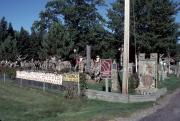| Additional Information: | A 'site file' exists for this property. It contains additional information such as correspondence, newspaper clippings, or historical information. It is a public record and may be viewed in person at the Wisconsin Historical Society, State Historic Preservation Office.
REJECTED BY HCRS 9/1980. SEVERAL FREE STANDING SCULTURES DECORATED W/FOUND OBJECTS. LOCATED ON 1/2 ACRE OF LAND ADJACENT TO ARTIST'S HOME.
The Wisconsin Concrete Park is one of the nation's most impressive and imaginative works of folk art. Art historians compare this fanciful and charming sculptural environment to the Watts Towers in Los Angeles and the Garden of Eden in Lucas, Kansas. The artwork covers two acres within a sixteen-acre county park, landscaped with balsam and red pine. In the wooded landscape, the sculptures present whimsical forms and surrealistic tableaus created of concrete, common objects, ceramics, and glass.
Fred Smith was a native of Price County and a retired lumberjack, farmer, and tavern owner. A self-taught artist who claimed not to know why he created this work, he was little affected by formal stylistic tradition and demonstrates an intuitive sense of form and design.
Between 1949 and 1963, when a stroke crippled him, Smith created 255 folk-art statues and plaques, many of them grouped within fifty-eight thematic arrangements, forming a single, cohesive statement of patriotism and a mythic vision of his Wisconsin roots. He embedded concrete figures with glittering fragments of glass, mirrors, and whole bottles, along with such other found objects as automobile taillights, electrical insulators, harnesses, animal skulls, and antlers. Most of the sculptures are life-size or even colossal. There are regional folk figures such as fifteen-foot-tall Paul Bunyan (with hundreds of cone-shaped, automobile taillights adorning his jacket); historical figures including Abraham Lincoln, Sacajawea, and Kit Carson; and archetypes like lumberjacks, Indians, and farmers.
His earliest sculptures were freestanding bas-reliefs, but the three-dimensional sculptures are the most interesting. Near the entrance to the park is “Chiann the Beer Drinker,” based on a real cowboy, here wearing a decorated sombrero and drinking a Rhinelander beer. “Woman and Angel” shows a woman arrayed in a glass-encrusted garment lifting her arms heavenward, her wings extended as if in flight, signifying immortality. The Tree of Life at her feet represents regeneration. Near this tableau is “Muskie Pulled by Horses,” inspired by a tall tale of a 20-foot muskellunge that took a team of horses to pull it out of Soo Lake. Perhaps the most amazing and ambitious sculpture, located at the park’s eastern edge, is “Budweiser Clydesdale Team”: eight draft horses, pulling a wagon.
Smith cast his figures with a mold so that the painted faces are nearly identical, with large, blank eyes, long, straight noses, and small mouths. The bodies are wide, blocky, and rigid, and their arms are stiff and disproportionately thin. Yet they gain vitality from the myriad colorful materials encrusting their bodies, from the glint of sunlight on glass and mirrored surfaces, and from the eccentric juxtaposition of images.
In 1977, the year after Smith died, a major storm damaged the fragile sculptures and flattened much of the surrounding forest, which had been a part of the sculptural environment. The Wisconsin Arts Board, the National Endowment for the Arts, and the Kohler Foundation acquired the property and restored the sculptures in 1978. The Kohler Foundation donated the property to Price County, which maintains it as a park and museum. |
|---|





